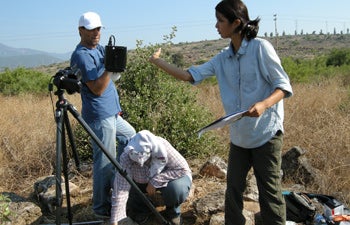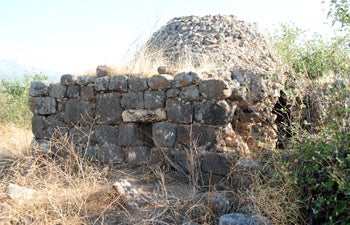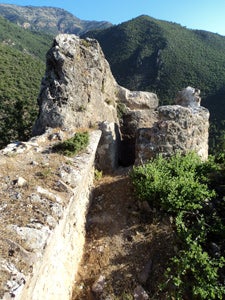Clues from Ancient Antioch
Lynn Swartz Dodd and her students had heard rumblings of a 10th-century cemetery deep in the brush in the Hatay region of Turkey near Antakya, the ancient city of Antioch.
But no one had ever translated the inscribed gravestones to decipher who was buried there.
Carrying heavy bags of high-tech imaging equipment and slashing through overgrown cotton fields in 90-degree heat, Dodd’s team became the first.
“It’s very physically taxing,” said Michelle Lim, a junior majoring in archaeology and narrative studies in USC Dornsife. “Archaeology is strenuous work.”
Lim and the other students were in Turkey to search for and study still-undiscovered ancient sites. They found 14 in five days. The undergraduates were taking USC Dornsife’s Problems Without Passports’ (PWP) first “Field Methods in Archaeology” course in Turkey. Their month-long course that began June 8 also earned them four units.
“For one month we worked them from dawn to dusk,” said Dodd, lecturer in USC Dornsife and curator of the USC Archaeology Research Center, who taught the course.
“She’s not kidding,” said Sarah Butler, a senior majoring in East Asian area studies and archaeology. “We were up at 4 a.m., out by 5, back by 1 p.m. for lunch, then working again until sunset.”
The archeology course was among eight offered by PWP this past summer combining research with study in a foreign country or Washington D.C. In Turkey, Dodd taught students how to use the geographic information system (GIS) and identify possible sites using satellite imagery. She gave lessons on field mapping, survey and excavation techniques and recording their findings.
Nearly all the work took place outside the classroom. In addition to using satellite imagery to spot possible ancient sites, they walked through villages talking to locals about locations of ruins and farmers who may have noticed copious pottery shards in their fields.

Michelle Lim, a junior majoring in archaeology and narrative studies in USC Dornsife, directs professors and students from the United States, Canada and Turkey in a high-technology photo shoot at a cemetery near the ancient city of Antioch. Photo by Mine Temiz.
“Archaeology is just as much about interacting with the people in the local culture as it is about documenting sites and digging up artifacts,” Lim said. “Some of our best leads came from talking to locals.”
At the cemetery, setting up the camera differed greatly from the controlled setting of a museum, where several days earlier, Dodd and her students had begun training a team of professors and graduate students from Turkey how to use the imaging equipment.
Besides clearing brush, students dealt with the blazing sun that required special camera filters. Lim showed the Turkish team how to capture high resolution digital images of the headstones. Once back in the laboratory, the computer images would enable scholars and students to move a light around them to research tiny details.
Lim took photos of the grave markers and a giant stone tomb dome. After returning to their home base, they studied the images, transcribing the inscriptions to make out names and dates.
“It’s sort of like building blocks to writing a bigger history of the region,” said Dodd, who has researched in Turkey with students for a decade but never as a course. “It’s similar to doing molecular biology and researching the tiny cancer cells before you can find cancer cures. This particular cemetery is important because it’s the only example of an early Turkmen cemetery with gravestone inscriptions in this region.”

USC Dornsife students documented a large stone tomb dome at the cemetery in the Hatay region of Turkey near Antakya, the ancient city of Antioch. Photo courtesy of Lynn Swartz Dodd.
Some discoveries were serendipitous.
When the team investigated the cemetery, they walked around the area and noticed columns and large block stones.
“We got a closer look and found pottery everywhere,” Butler said. “We found divots in stone that people used to grind food like nuts and herbs. We surveyed the area and decided it was once a major grinding mill, possibly an olive oil press.”
“It had never been documented,” Dodd said. “This is why our team goes to that part of Turkey. There are so many ancient sites yet to be discovered.”
On weekends, Dodd took students on field trips, one to the cave of St. Peter, the place where the earliest Christian groups met when the Roman Empire considered them outlaws.
“We climbed up an ancient escape route,” Butler recounted. “When the Romans were coming, the Christians ran into a hole that tunneled out to another part of the mountain.”
Students took images of a royal sculpture from the Hittite period in the Hatay Archaeology Museum, excavated from the Alalakh site that had been ruled by Amorites during the Middle Bronze Age, later conquered by the Hittites in the second half of the 2nd millennium BC. Lim stayed an extra month in Turkey, teaching the professors and students from the United States, Turkey and Canada how to use the advanced imaging techniques she learned in the course.
Butler sketched dozens of pottery shards she unearthed. Each technical drawing of pottery pieces in their actual sizes was later compared to images in a scholarly book of pottery vessels from different periods.
“Just from two little pieces of pottery we can reconstruct the whole shape of the bowl,” Butler said, displaying her pencil drawing and matching it to an image of a bowl in the book.

The Problems Without Passports students discovered and documented castle ruins in Turkey where in 12th century soldiers serving a European Christian prince guarded the Crusader kingdom’s roads in the valley below. Photo courtesy of Lynn Swartz Dodd.
Another highlight was hearing from locals about a castle on a hill.
“We climbed this massive hill just hoping something would be at the top,” Butler recalled. “The hike up was breathtaking. There were mountains as far as the eye could see.”
At the top they found it. There stood the castle ruins where in the 12th century soldiers serving a European Christian prince guarded the Crusader kingdom’s roads in the valley below.
“But even the littlest discovery is very exciting to me,” Lim said. “It’s putting together little pieces of the puzzle — especially when you know the significance of each little find. Even if it’s a small bead or a piece of a pottery jar, you are the one who uncovered it after it was buried in the ground for 3,000 years. That in itself is a victory.”
Images which allow users to move a light around a super high-resolution photograph of an ancient inscription — called reflection transmission imaging, or RTI — can be viewed in USC Dornsife’s InscriptiFact image library. Watch a video http://www.youtube.com/watch?v=ZBvwludm5yw or visit http://ancientworldonline.blogspot.com/2011/08/inscriptifact-update.html